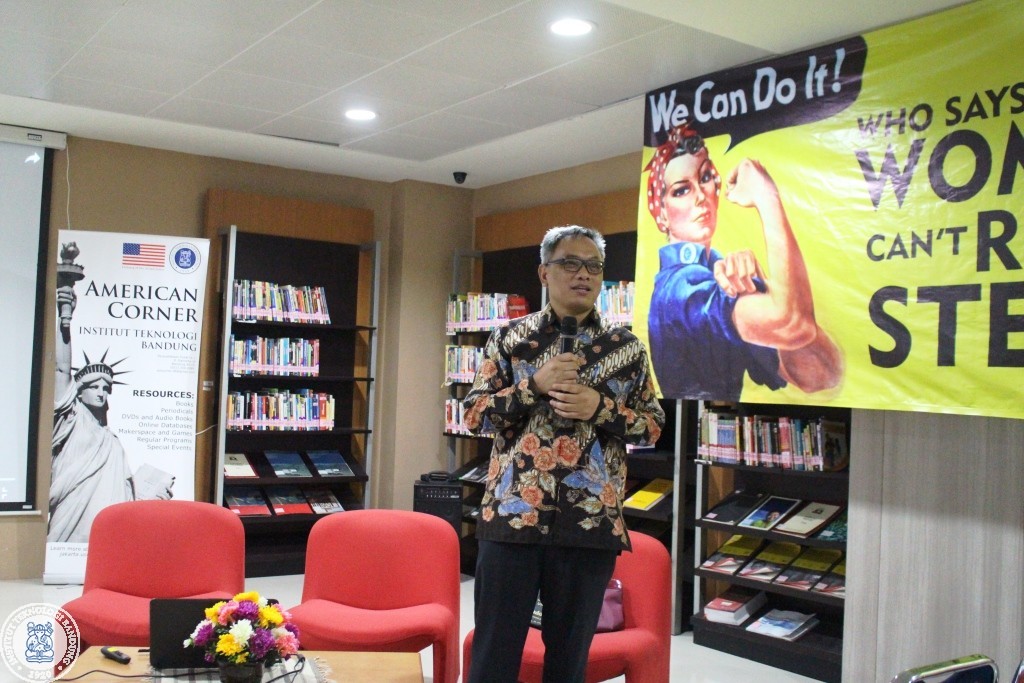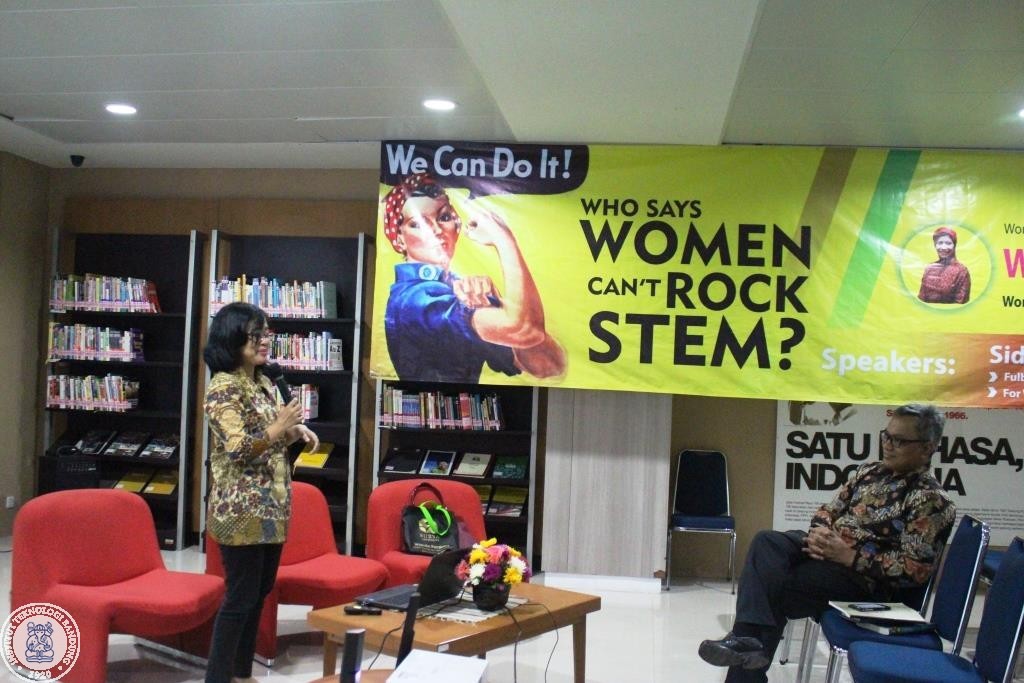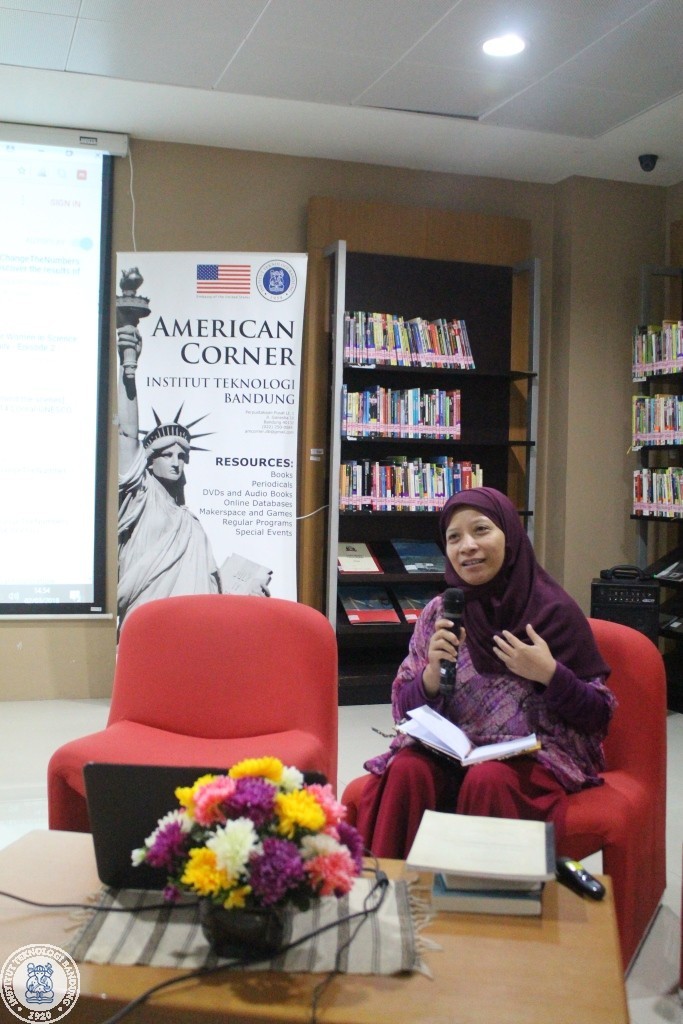Women STEMpowerment: Gender Equality Begins with Small Things
By Fivien Nur Savitri, ST, MT
Editor Fivien Nur Savitri, ST, MT

BANDUNG, itb.ac.id-American Corner of Institut Teknologi Bandung (ITB) honor the empowerment of women in the field of STEM (Science, Technology, Engineering, and Mathematics) by organizing Women STEMPowerment on Friday (02/03/2017) in the Multipurpose Room,ITB Central Library. The event is entitled "Who Says Women Can’t Rock STEM?" as part of a seminar series titled Women Empowerment Series 2017/2018.
American Corner invited Sidrotun Naim, Ph.D. as the main speaker in this event. Sidrotun Naim talked about her opinions and experiences in areas relevant to STEM as well as how the women's movement was and should be carried out. She also talked about Indonesian and Western literature relevant to the women movement.
Also present at Women STEMpowerment, Prof. Dr. Ismunandar, a Professor in Chemistry at FMIPA ITB, and Lusia Marliana Nurani, Ph.D., the Advisor of American Corner of ITB.
The Background of Indonesian Women Movement
Naim sought to provide a broader context for women's empowerment and not limiting her explanation to the field of STEM. She gave the historical background of women's movement in Indonesia which started since the First Indonesian Women's Congress in Yogyakarta on 22-25 December 1928, less than three months after the Second Youth Congress on 27-28 October 1928.
Citing Susan Blackburn's book titled "Kongres Perempuan Pertama: Tinjauan Ulang", Naim pointed out that during that period, women were scorned by society when trying to gather. The society commented that women have no reason to conduct congresses and the affairs of governing the country should be for youth and men only. In fact, at the First Indonesian Women's Congress, education and marriage rights were discussed.
This congress is the reason why, on every 22 December, Indonesia celebrates National Mother’s Day. It is to commemorate a historic event of Indonesian women’s movement, the First Indonesian Women’s Congress.
The Movement of Western and Indonesian Women
In the West, the rise of women was marked in the early 20th century by women’s right to participate in politics, especially the right to vote and be elected. Indonesia, since its first election in 1955, has given women more extensive political rights. Naim noted that in fact, the women’s movement in Indonesia has been more advanced in the beginning. Indonesia has promoted women's rights, especially in politics at that time, and provided public spaces for women to voice their opinions.
This Fulbright alumnus also took the example of Marguerite de Witt-Schlumberger, a female feminist and a French suffragette. Marguerite was the president of Union française pour le suffrage des femmes/UFSF, translated as the French Union for Women's Rights. Marguerite married to the Schlumberger family and built the Schlumberger Foundation Faculty for the Future. The Schlumberger Foundation then focuses on STEM education for women and helps Naim completed her studies.
Naim also made an analogy of women's movements in 1917 and 2017. In 1917, the suffragettes paraded on the streets of New York City holding placards containing signatures of more than one million United States women who demanded their political rights. A hundred years later, Women's March was held in the United States and elsewhere around the world, in reaction to the inauguration of US President Donald Trump and fears of new administrative policies that may be discriminatory against women. Naim commented that ultimately the unifier of women around the world is none other than Donald Trump.
In women’s movement, according to Naim, women should support each other. Naim commented on the debate about Kartini Day celebrated on every 21st of April. Much of the debate take on the reason why only Kartini's name is used when there are numerous other heroines. Naim responded that the number of heroines is only a few and they should be honored together. Those heroines are unique in their own local context. We cannot compare the social context of Aceh women with Javanese women like Kartini.
Furthermore, Naim suggested that women’s movement should not make men the opponent. Feminist narrative, she argued, looks somewhat offensive to men. When she was studying at the John F. Kennedy School of Government, the heaviest debate took place on the issue of men and women. Naim observed that women often directly attack the views of men, even when the man supports what women say. This is a mistake in women’s movement, Naim added.
Woman’s Self
Moving on to something more fundamental, Naim mentioned that philosophically and ontologically, men and women come from the same soul. In Islamic tradition, men and women are created from the same ‘nafs’. Biologically, portion for women and men in the human chromosome is the same, 50% - 50%. Although there is a presumption that men are more contributing to chromosomes, molecular biology proves that this is not so. In the end, Naim emphasized, what causes a huge difference between men and women in society is the social construction around men and women.
Social construction is different everywhere. In Arab, for example, kinship is based on male line. However, in Solo, kinship is based on both male and female lines. This is a very interesting according to Naim, highlighting the diversity of women's roles and social construction in each region.
Furthermore, this Harvard University alumnus talked about the icon of Indonesian women, Pratiwi Sudarmono, Indonesia's first female astronaut. At that time, Indonesia was the only country besides the United States that had satellites covering all of its own region, in line with the vision of the Minister of Research and Technology at that time, B. J. Habibie. Pratiwi Sudarmono, a microbiology scientist graduated from Osaka University, was selected to be a payload specialist in the NASA STS-61-H Space Station mission.
Pratiwi was initially reluctant to participate because the cost to dispatch astronauts reached billions and she felt it was better to give the money to the people. Moreover, Pratiwi's husband did not agree if Pratiwi joined the mission. Finally, Pratiwi asked for the help of Doddy Achdiat Tisna Amidjaja, the 21st rector of Institut Teknologi Bandung, to persuade her husband to approve Pratiwi's departure. Although her mission was canceled due to the Challenger Disaster, Pratiwi’s story is a pride for women's role in the field of STEM and a proof that women are equal to men.
Building Gender Equality
Evidence that social construction contributes more to the gap between men and women comes from classical music industry. In 1970, the best five orchestras in the United States only had 5% female of the total players.
In 1980, the figure rose to 10%. In 1997, women's participation increased to 25-30% of total musicians. What happened? Change is not possible in the number of orchestra players because it tends to be stable, which is about 100 people.
Quoting What Works: Gender Equality by Design, Naim explained that the solution was as simple as a blind test. The audition judges were required to listen only to the sound of the instrument and forbidden to see the player. Between the judges and musicians, a curtain was placed so that the judge would mark objectively. The curtain caused the rise of women's participation in the orchestra.
Naim added that during her studies at Harvard University, large and small classes division is required. Why? Apparently, the marginalized groups-such as women, blacks, and disabilities-are more vocal in a small class. Women, in particular, tend to dislike competition compared to men. This division effectively gives voices to people whose voices are lower in large classes. According to Naim, this scheme can be applied to universities in Indonesia. Prof. Ismunandar, when asked by Naim about women participation his class, said that there is no difference between the performance of male and female students in her class.
The United States government under Obama had also encouraged young women to be more involved in the field of STEM. In a video titled Girls in STEM: A New Generation of Women in Science, President Obama met directly with young female innovators. The women gave presentation in front of President Obama about what they made. Naim added that the children who met directly with Obama who see their works would always be consistent in their path.
In Indonesia, the government has mandated quota for women legislative candidates to political parties who want to participate in the legislative election. Naim also said that Indonesia already had a female president, ahead of the United States. We should optimize the human resources we have if we lack women's participation.
Naim also said that our workplace is not women-friendly yet. Naim gave an example of her female friend who is uncomfortable to live in the same barracks with men. Supposedly, there is an accommodation provided for this woman so that she feels comfortable when working.
Various measures and policies have been implemented to provide representative women's participation in workplace. The policy starts from simple things, such as blind tests for job vacaancies, to more complex matters, such as enforcement of regulations that ensure representative participation of women. These changes are in our hands. Gender equality is not a dream if we as a society really move together toward that goal.



.jpg)
.png)
.jpg)
.jpg)
.jpg)

.jpg)

